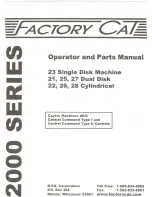
5
PI-198
December 2020
11. Properly tighten all high pressure connections. All NPT connections
must have a minimum engagement of four (4) threads. Pipe (NPT)
connections should be made up hand tight plus two (2) full wrenched
turns.
Do not
tighten NPT threads past two (2) wrenched turns.
Use wrench flats (when available) or a properly adjusted
smooth jaw plier wrench (JS PN 64119) for tightening components.
Avoid using pipe wrench as wrench marks will cause high pressure
components to crack and fail.
12. All high pressure hose connections require a hose restraint (whip
check), including connection at fluid end discharge.
13. Before attaching a nozzle to the control gun or tube cleaning lance,
operate the pump at low speed to purge
dirt and debris from system.
Dirt and debris can clog nozzle orifice(s) and cause excessive
system pressure which could lead to a lance failure.
14. With nozzle installed,
operate the pump at a low speed (low
pressure) for test
. Should system repairs or adjustments be necessary,
stop pump and relieve all pressure before making required repairs or
adjustments. The pump operator should watch the nozzle operator at all
times in case any difficulty arises and it becomes necessary to depressur-
ize system. If the pump operator does not have a clear line of sight to the
nozzle operator, it may be necessary to have another employee available
to communicate between the nozzle and pump operators.
15. With the system operating properly,
increase pump speed slowly
until operating pressure is reached
and adjusted. Pressure adjust-
ments should always be made slowly. The nozzle operator shall be
warned before any pressure adjustment is made by the pump operator.
A sudden change in reaction force may cause the nozzle operator to lose
balance.
16. Use
minimum pressure required
for cleaning. Do not exceed the
operating pressure of the system’s lowest pressure-rated component.
All equipment pressure rating markers and warning tags should be left
intact.
17. Waterblast operators must be made aware that the
cleaning nozzle’s
discharge jets(s) can inflict serious body wounds
. Supervisors should
demonstrate the potential danger of discharge jet(s) by showing all new
operators the effect of a waterjet by cutting a scrap piece of wood such
as a 2” x 4”.






































